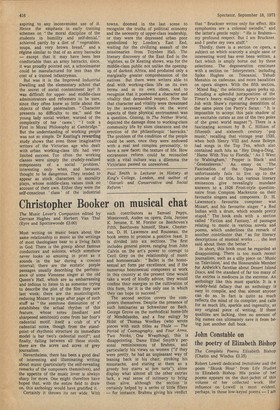Christopher Booker on musical chat
The Music Lover's Companion edited by Gervase Hughes and Herbert Van Thal (Eyre and Spottiswoode £3.00) Most writing on music bears about the same relationship to music as the writings of most theologians bear to a living faith in God. There is the gossip about famous conductors and soloists, which somehow never looks so amusing in print as it sounds in the bar during a concert interval; there are the ecstatic purple passages usually describing the performance of some Viennese singer at the old Queen's Hall, which are as embarrassing and tedious to listen to as someone trying to describe the plot of the film they saw last week; there are the musicologists, reducing Mozart to page after page of such stuff as "the semitone diminution of x' establishes the actual rhythm of this feature, whose notes (mediant and sharpened semitonic) come from bar four's cadential motif, itself a crab of x"s cadential notes, though from the standpoint of rhythmic structure its immediate model is bar two's cadential motif"; and finally, falling between all these stools, there are the acres and acres of grey journalism.
Nevertheless, there has been a good deal of interesting and illuminating writing about music (particularly the self-revealing remarks of the composers themselves), and the appetite of the music lover is always sharp for more. One might therefore have hoped that, with the entire field to draw on, this anthology would have gratified it. Certainly it throws its net wide. With such contributors as Samuel Pepys, Monteverdi, Auden on opera, Zola, Jerome K. Jerome, E. M. Forster on Beethoven's Fifth, Beethoven himself, Shaw, Chesterton, D. H. Lawrence and Rousseau, the book seems to promise a positive feast. It is divided into six sections. The first includes general pieces, ranging from John Calvin on the art's power to corrupt to Cecil Grey on the relationship of music and homosexuals : "Ballet is the homosexual art form par excellence, and if the numerous homosexual composers at work in this country at the present time would take a word of kindly advice, they would confine their energies to the cultivation of this form, for it is the only one in which they can hope to succeed."
The second section covers the composers themselves. Despite the presence of such luminaries as Schweitzer on Bach, George Grove on the methodical home-life of Mendelssohn, and a fine eulogy by Hoist of Thomas Weelkes (who wrote pieces with such titles as Thule — The Period of Cosmography, and Four Arms, Two Necks, One Wreathing), this is disappointing. Dame Ethel Smyth's personal reminiscences of Brahms, and particularly his views on women ("if they were pretty, he had an unpleasant way of leaning back in his chair, stroking his moustache, and staring at them as a greedy boy stares at jam tarts"), alone display what almost all the other entries lack, a real sense of intimacy to bring them alive, although the section is certainly helped by a series of little fillers — for instance, Brahms giving his verdict that " Bruckner writes only for effect. His symphonies are a colossal swindle," and the latter's gentle reply : " He is Brahmsmy profound respect. But I am Bruckner, and I prefer my own stuff."
Thirdly, there is a section on opera, a subject on which scarcely a single sane or interesting word has ever been written, a fact which is amply borne out by these selections. The degeneration continues with a section on 'Interpreters,' including Spike Hughes on Toscanini, Yehudi Menuhin on cadenzas, and more banalities on opera singers. With the fifth section, 'Mixed Bag,' the selection again perks up, including a splendid juxtaposition of the Times's heavy eulogy of Parry's oratorio Job with Shaw's riproaring demolition of the same piece (on Parry's Satan : "It is impossible to accept this pale shadow of an excitable curate as one of the two poles of the great world magnet "). There is a fascinating account by B. C. Hilliam of fifteenth and sixteenth century 'pop music,' recalling that vintage year 1530, when both Henry VIII and Anne Boleyn had songs in the Top Ten, which also contained such hits as 'Hey Ding-a-Ding,' ' Hame With You to Florida,' As I Went to Walsingham," Pepper is Black' and Greensleeves.' An essay on 'The Fascination of the Opus Number' unfortunately fails to live up to the promise of its title, but various literary eminences give revealingly mundane answers to a 1926 Frost-style questionnaire from Compton Mackenzie on their favourite singers and composers. D. H. Lawrence's favourite composer was Mozart, and his favourite singer "a Red Indian with a drum, which sounds pretty stupid." The book ends with a section called 'Fiction and Fantasy,' of passages relating to music in various novels and poems, which underlines the remark of another contributor that "as for literary descriptions of musical works ... the less said about them the better."
In short, this book must be regarded as disappointing. There is too much recent journalism, such as a silly piece on Music on Television,' and the Honourable Member for Ardwick's facetiae about Desert Island Discs, and the standard of far too many of the entries is mediocre in the extreme. An anthology like this must sparkle. It is a widely-held fallacy that an anthology is easy to compile, and that almost anyone can do so. In fact is quite as much reflects the mind of its compiler, and calls for as much life, sparkle and ingenuity, as any original piece of writing. If these qualities are lacking, then no amount of big names can ultimately save it from being just another dull book.


































 Previous page
Previous page